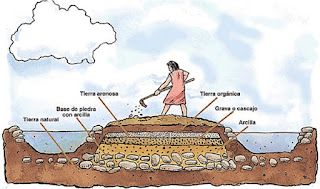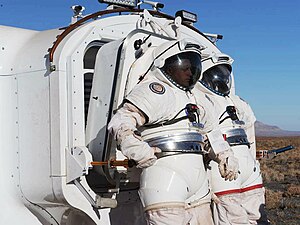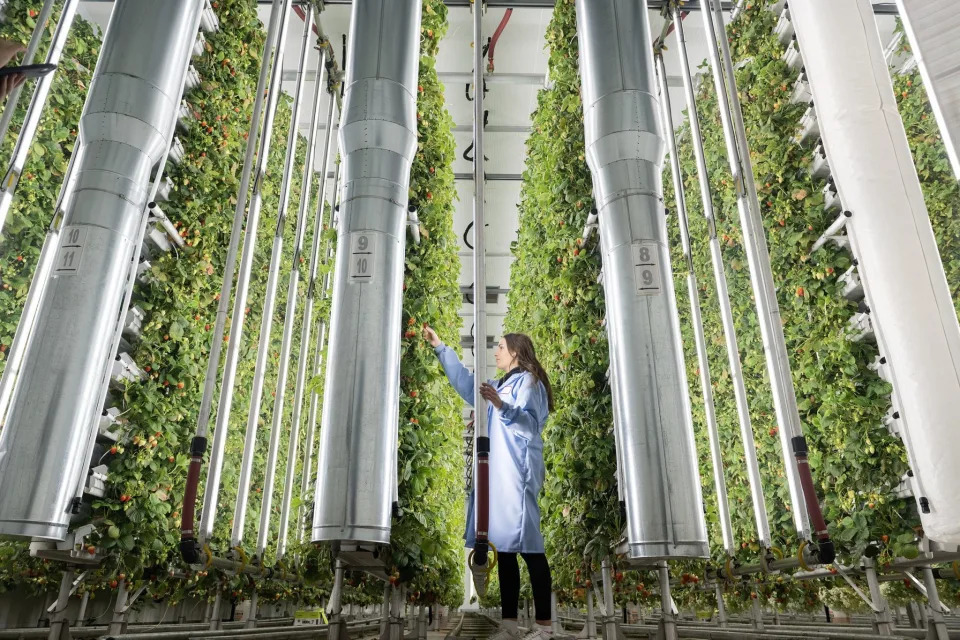New Mars Forums
You are not logged in.
- Topics: Active | Unanswered
Announcement
#26 2016-10-30 21:46:07
- SpaceNut
- Administrator
- From: New Hampshire
- Registered: 2004-07-22
- Posts: 28,959
Re: starving on five acres
I forgot this past work....and we were working towards crop growing cycle which is the last peice of the puzzle for a healthy diet for menu. But we also know that fresh crops only have a few weeks or so and will need to be processed to allow for it to be used later. Not sure did we get that far in the topic....will need to read back through it to see.....
Offline
#27 2016-11-20 15:58:17
- Void
- Member
- Registered: 2011-12-29
- Posts: 7,142
Re: starving on five acres
Raised field agriculture.
I am simply adding this for consideration. Perhaps it could be of use.
http://wideurbanworld.blogspot.com/2012 … ystem.html
quote:
Raised fields -- an ancient form of agriculture, practiced by the Mayas, Aztecs, and the ancestors of the Incas -- was one of the most productive preindustrial farming systems anywhere.
http://archaeology.about.com/od/neolith … arming.htm
quote:
The Chinampa field system is a method of raised field agriculture best suited to wetlands and the margins of lakes. Chinampas are constructed using a network of canals and narrow fields, built up and refreshed from the organic-rich canal muck.
Why I think this could be useful on the surface, is that one of the functions of the water canals, is to ward off frost. On the other hand, if used in a Martian greenhouse, the water cooled overnight could be a heat sink to ward off overheating, therefore allowing the use of heliostats mirrors to boost the illumination inside the greenhouse.
The question of what to grow in the greenhouse canals would depend on what was wanted. Reeds for artificial wood, or duckweed for food.
I realize that duckweed has appeared on this site before, but still...
http://portablefarms.com/2016/is-duckwe … he-future/
quote:
Duckweed MAY be the food of the future. There is no doubt about that. Grown under ideal conditions, duckweed ranges between 25% and 45% protein and doubles its growth every 36 hours, and OUR TILAPIA love to eat it.
http://www.offthegridnews.com/how-to-2/ … -duckweed/
quote:
Duckweed packs crude protein of 35 to 43 percent, fiber of 5 to 15 percent, polyunsaturated fat of 5 percent, and a host of trace minerals, calcium and Vitamins A and B. Its protein content is said to be equal to that of dried soybean meal. Not limited only to ducks, duckweed is fed to swine, chicken, cattle, sheep, goats, rabbits and farmed fish in many developing countries, with very positive results.
Duckweed is probably the smallest but fastest-growing plant there is. Grown in ideal conditions, it can double its weight in just 16-48 hours. Farmers who grow feed crops have found duckweed to be much more productive than soybean in terms of protein per surface area. It can produce 5-8 tons of dry matter for every acre per year, while soybeans produce less than a ton per acre each year depending on species, nutrient supply in the water, climate and environmental conditions.
Common duckweed, or lemna minor, grows in thick blanket-like mats on fresh or brackish still waters such as ponds, lagoons, swamps and slow-moving streams, especially those containing high amounts of nutrients like nitrogen and phosphorous. That’s why it’s often found in wastewater coming from residential areas, crop farms, hog and poultry operations, cattle feedlots, slaughterhouses and food processing plants, where effluent, excess fertilizers and slurry abound.
HUMAN CONSUMPTION
But the best thing about duckweed is that it is also edible for humans. Duckweed resembles in taste to watercress or spinach. The wolffia genus has traditionally played a role in Asian cuisine, where it is used as a nutritious vegetable by the Thai, Burmese and Laotians. Duckweed can be mixed into soups and salad, or used in sandwiches as a substitute for alfalfa, lettuce, watercress or spinach.
I am guessing that human waste could be anaerobically digested to produce Methane, and further altered by some sterilization method, and then put into the canals to be processed further.
This should help to generate the soil you want.
I expect that another way to generate more soil would be to extract Carbon from the atmosphere, and dump that into the canals also to be processed by micro-organisms.
If this were done inside a sandstone cave, with artificial lights, then temperature fluctuations won't be a consideration.
Otherwise I am thinking that trenches on the surface of sandstone could provide walls, and then a convex greenhouse roof placed in those.
The air pressure inside would push the convex structure against the walls. So it would be more compressive than tensile in nature.
Obviously this requires a significant source of water in the first place, and fairly tight recycling of water.
Somethings to consider. Just thought I would put them here.
Last edited by Void (2016-11-20 16:28:02)
Done.
Offline
#28 2016-11-20 16:28:35
- Void
- Member
- Registered: 2011-12-29
- Posts: 7,142
Re: starving on five acres
Cut sandstone greenhouse.
I feel like discussing this a bit more.
The sandstone should be relatively easy to carve trenches into. In doing so, perhaps sandstone blocks can be cut, and so further providing a useful material.
Although low pressure greenhouses are not mandated, I think this could lend itself to be useful for low pressure greenhouses.
I don't know what plant tolerance will be. Certainly water cannot boil. I have seen members say that the lower the pressure, the more evaporation from the plants. To counter this having more CO2, will allow the plants to get more Carbon, so they can keep their stomata closed off more.
How low the pressure?
Higher than the boiling point of the water.
Probabbly high enough so that human blood does not boil.
I am not saying that some or all greenhouses could not be at 1 bar, but I am thinking that because, Mars is eventually to be terraformed, and a 1 bar atmosphere for Mars is not guaranteed or soon coming, it would not hurt at all to practice agriculture at low pressures, possibly modifying the crops to greater tolerance to lower pressures over time.
So, at least in some cases, I am thinking of greenhouse pressures below 250 mb, which will require a pressure suit for humans. Probably the reader is not too enthusiastic about that, but I will try to justify it will a special "Suit".
I have mentioned something like this before, but this is a modification of it.
In this case a pressurized "Boat" suit. Most likely @ 250-300 mb O2 inside.
In the case where there were to be a canal with duckweed in it, the boat could be mobilized from one trench location to another without wheels and the problems associated.
Most of you like this:
https://en.wikipedia.org/wiki/Space_activity_suit
However I intend to only have the arms as counter pressure. The rest of the suit would be balloon, but usually the balloon portion would not be inflated, because the person will be inside the "Boat". In such a case the suit is just a precaution against the possibility that the boat interior would depressurize. The suit would potentially save the persons life.
This might help for visualization. (Yes this guy actually dived in it).
http://www.seagrant.wisc.edu/madisonjas … _1700.html
The boat is to be large enough that a person or persons could inhabit it for days at a time.
It would have two arm portholes with spring loaded doors which can seal off the air pressure.
The person would access the outside with their arms by pushing their counter pressure protected hands and arms into the holes to the outside. This becomes practical (Perhaps), if their arms have built into them a "Cork-Seal" that plugs the portholes when the arms are fully inserted. But to make this less silly, I add that they will be inserting their arms into balloon arms and gloves on the outside fixed to the outside of the portholes. This might puzzle you as to how helpful this could be because they would have both counter pressure arms and hands, and balloon protection over the arms. It might seem rather clumsy.
The answer is that once the arms are plugged into the ports securely sealing the differential pressure, there are two options for improvement of utility.
1) The balloon gloves can be pumped empty of air, so the hands will not have to fight both the counter pressure gloves and the balloon gloves.
2) After #1 is done, the balloon gloves can be taken off, since you have two hands on the outside.
I presume that the layout of the crops will be such that a human situated like this could manipulate the plants sufficiently. Here I am describing a "Barrel" which is fixed to the boat, but their should be possibility to have sealed joints in the barrel to increase mobility of the human.
Two methods of extraction of the arms into the Barrel/boat would exist.
1) Put the balloon gloves on, then simply uncork, and pull the arms in. Yes a bit of air will gush into the balloon arms and gloves, or they could be gently pressurized first.
2) In the event that you could not get the balloon arms/gloves back on, I suspect that a good design would allow one arm to be pulled out at a time, and that event would lead to depressurization until the spring loaded door snapped shut. But this might not work out too bad because remember the human is in a balloon suit with the exception of the arms and hands. (Those have counter pressure protection).
If there were more than one person in the boat, then you would definitely want to provide some protection to the other people when this was done.
If it were me, I would want to take a coffee break every 2 hours during the working day.
So, to facilitate that I will describe a variation on what has just been said.
The variation:
1) Just put only one of your arms out of the barrel. In most cases it would be the right arm.
2) The left arm staying inside, could operate a robotic arm from the inside. So in addition to your right arm outside, you would have an assisting robotic arm operated by your left hand and perhaps voice commands.
This would probably be much more comfortable than both arms out, and I suspect that your use of the right arm would be better.
Further if you were fairly confident of the seal of the arm ports, you could actually open your helmet and eat a sandwich, drink coffee, and yes perhaps pee, without withdrawing your arm. You would of course have to be able to drop your pants, and reconnect everything either with your left arm or with humiliating assistance from someone else.
Another option of course would be to simply withdraw your right arm into the barrel, and let the port door shut.
The of course you would have both hands to use.
It becomes obvious that with this suit, at least you don't have to pee yourself, or poop your pants.
If you are in the boat/barrel/cabin with pressurization, and have counter pressure gear on your arm(s), then that will become uncomfortable in a few minutes. So, rather than to have to take the arm/glove(s) off and put them on each coffee break, I recommend a arm/hand sized vacuum chamber inside the cab which can be sucked down sufficiently when the arm is inserted into it.
So you would be using your left arm perhaps to eat your lunch, while the right arm is in counter pressure and vacuum.
There would be brief exceptions to that rule to perform special functions best done with two hands ![]()
Well you can at least say "That's different!"
That's all.
Last edited by Void (2016-11-20 17:22:23)
Done.
Offline
#29 2016-11-20 18:28:14
- SpaceNut
- Administrator
- From: New Hampshire
- Registered: 2004-07-22
- Posts: 28,959
Re: starving on five acres
I would think that once we can make large structures to house these gardens in that they will take on the many uses for agriculture types as well as for cleaning of water sources. Some will serve as waste treatment while others will be used to make bio oil.
neat way to scubber dive for the food in the water. once we start to be able to have that much liquid water around to make use of.
Offline
#30 2016-11-20 19:22:13
- RobertDyck
- Moderator
- From: Winnipeg, Canada
- Registered: 2002-08-20
- Posts: 7,813
- Website
Re: starving on five acres
If researchers find a way to quickly don and doff an MCP suit, there's no need for a partial. But if you want a "boat suit" then just use a Suitport.


Offline
#31 2016-11-20 19:37:48
- RobertDyck
- Moderator
- From: Winnipeg, Canada
- Registered: 2002-08-20
- Posts: 7,813
- Website
Re: starving on five acres
Guelph university found plants could thrive in pressure as low as 10 kPa = 100 mbar = 1.45 psi = 0.09869 atmosphere. Without special conditioning, humans can breathe 3.0 psi pure oxygen = 20.68 kPa = 206.8 mbar = 0.204 atmosphere. With high altitude training, a strong healthy young (not middle-age) individual can breathe 2.5 psi pure oxygen = 172 mbar = 17.2 kPa. Low pressure causes plants to transpire more water through their leaves, but that will condense on cold walls, can be collected and run back into soil. Low pressure will also cause human lungs to dehydrate; you need high relative humidity to avoid lung tissue drying and cracking causing bleeding. And limit time in extreme low pressure. It's safer for humans to stay in 3.0 psi or higher. Apollo was originally going to use 3.3 psi so the suit could endure 10% pressure loss without risk to the astronaut, but in the end they used 3.7 psi = 25.5 kPa.
Offline
#32 2016-11-20 19:54:30
- SpaceNut
- Administrator
- From: New Hampshire
- Registered: 2004-07-22
- Posts: 28,959
Re: starving on five acres
Here are the Nasa underwater training images
Offline
#33 2023-02-11 21:38:17
- SpaceNut
- Administrator
- From: New Hampshire
- Registered: 2004-07-22
- Posts: 28,959
Re: starving on five acres
If a structure is vertical on the 5 acres, then you have more area to grow the food.
A new agricultural revolution has started. Congress must invest now to secure the future of U.S. food
Offline
#34 2023-02-21 15:55:44
- Mars_B4_Moon
- Member
- Registered: 2006-03-23
- Posts: 9,330
Re: starving on five acres
Can Gardening In Space Help Astronauts Cope With Isolation?
https://spaceref.com/space-stations/can … isolation/
'It's Very Sad': Mixon Owners Discuss Decision To Sell Citrus Farm
https://patch.com/florida/bradenton/it- … itrus-farm
Fischer Farms reports successful wheat trial in vertical farm
https://www.thegrocer.co.uk/fruit-and-v … 89.article
The company itself is expanding with a new four-acre Norfolk farm
Current affairs help stir up world’s food vs. fuel debate
https://www.producer.com/opinion/curren … el-debate/
Here comes the world’s first offshore wind seaweed farm
https://electrek.co/2023/02/16/offshore … weed-farm/
Offline
#35 2023-05-20 16:47:13
- SpaceNut
- Administrator
- From: New Hampshire
- Registered: 2004-07-22
- Posts: 28,959
Re: starving on five acres
The topic lacking the quantity of crew or in this case people that it would take to starve once that population increased to that point.
Offline
